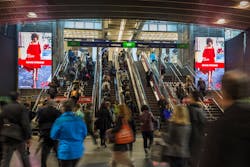The train tracks that crisscross America are the arteries that help pump raw materials and finished goods around the country, helping to serve as the lifeblood for the nation’s economy. Without rail transportation, the country’s economic engine would likely grind to a standstill. According to the Association of American Railroads, freight railroads support 1.5 million jobs, nearly $274 billion in economic output, and $88 billion dollars in annual wages. Rail is also green: transporting goods by freight can cut down on pollution, traffic and fuel costs. Added to the economic benefit is the ability to move people efficiently on a day-to-day basis. There was a 51 percent increase in ridership between 2001 and 2013 on Amtrak rail lines alone, according to the National Association of Railroad Passengers, including a spike in business travelers and students commuting.
But, despite all the advantages of rail transport, the industry has been challenged by a spate of derailments and crashes, prompting the government to put new safety laws into effect in 2014. According to the National Highway Safety Administration, 232 people died in railroad crossing accidents in 2016. The federal government has mandated that all railways implement an advanced technology, positive train control (PTC). PTC is designed to stop accidents like train-to-train collisions, derailments due to high speed, and problems from misaligned track switches. It also allows rail command and control centers to track all the trains running through their jurisdiction and even take over train operations should an emergency situation arise. Though the government’s deadline for implementing PTC has passed, only a staggering 10 percent of all American rail companies have met the goal.
Fine Pitch for Command and Control, Precision When It Matters
Despite the many advantages to PTC, the technology is only as good as the displays in the command and control centers. PTC operators are put in situations that require split-second decisions. And, to make the best-informed decision, they must have high-quality displays that don’t lose data in a bezel or LCD frame. The lives of thousands of passengers, the surrounding communities and billions of dollars in goods are at stake. And as America gradually transitions to high-speed rail, the need for the highest-quality command and control will only continue to grow.
The Spending Power of Happy Travelers
Outside of providing for a safer rail transportation environment, LED displays can also improve the experience of rail travel for passengers, both inside the train and at the station. Adding high-quality LED displays in the cars and stations helps with emergency messaging, way finding and passenger information. The presence of these displays also helps overcome the perception that rail travel is outmoded in America, and can help replicate the experience a passenger gets at an airport.
LED for Advertising
Advertisers are always eager to find ways to capture consumers’ attention. And just like displaying digital advertising at airports, shopping malls and any other place with a lot of foot traffic, rail stations and trains provide a great opportunity for advertisers to reach a large audience and for transit authorities to unlock an additional stream of revenue. From metropolitan subway systems, like the nation’s largest system in New York City, to Amtrak trains that run coast-to-coast, LED advertising will quickly become ubiquitous within the passenger rail industry. In 2016, $7.5 billion was spent on digital out-of-home advertising, and one-fifth of that money was spent on transit advertising alone, or $1.36 billion.
The newest generation of digital displays allows commuters to interact with them, participate in promotions and connect with social media. The displays can be linked to a cloud-based system and can gather valuable metrics about the passersby who interact with them. Ads can be changed in real time, based on the demographic of the people in a station or in a train at a given time of day.
LED for Information
Digital signage has evolved from a commuter luxury to a definitive necessity. It’s estimated that up to 95 percent of transit agencies in America now incorporate some kind of electronic sign system on their rail fleets. Every transit operator’s concern is finding the quickest and easiest ways of communicating with passengers to keep them informed of their vehicle’s real-time status. Agencies are resolving these concerns with elaborate electronic displays found in ticket booths, on and inside buses, on passenger waiting areas within bus shelters, overhead at rail platforms, and on board trains.
LED displays can be used in a myriad of ways to provide passengers about necessary travel information within stations, such as arrival and departure times, platform numbers, destinations, delays and train numbers. These displays can be designed with an open protocol so that they can be incorporated into any existing station management system, and their brightness and vibrancy can be tailored to the environment. They can be mounted in a variety of helpful locations, like above platforms, in tunnels and in underground passageways, to provide passengers with detailed information. The displays can be created in a variety of sizes and shapes and utilize both single-sided and double-sided formats. Kiosks created with multiple displays allow for the display of a large amount of relevant passenger information in one location. Outdoor displays can withstand any type of environment, including adverse weather conditions and extreme temperatures.
In addition, LED displays can be installed within train compartments to provide on-board passenger information. Displays mounted in the front, side and rear of train cars inform passengers about directions, intermediate stops, train numbers and types. On-board screens also provide useful information like train times and schedules, train speed and data, route maps, and outside weather conditions.
Transportation hubs like Toronto’s airport, with it’s innovative LED sculptural flower in the center of its atrium, and New Zealand’s state of the art Britomart, are raising the game for the implementation of LED displays to impart information to travelers. The rail industry is quickly catching up, understanding the value of using LED displays to heighten passenger experience, improve the efficiency with which people move about trains and stations, and to unlock a new stream of revenue through digital advertising.
NanoLumens is a member of the Digital Signage Federation, the only independent, not-for-profit trade organization serving the digital signage industry. The DSF supports and promotes the common business interests of worldwide digital signage, interactive technologies and digital out-of-home network industries. To learn more, go to www.digitalsignagefederation.org.
Larry O’Hagan is a business development associate at NanoLumens.




